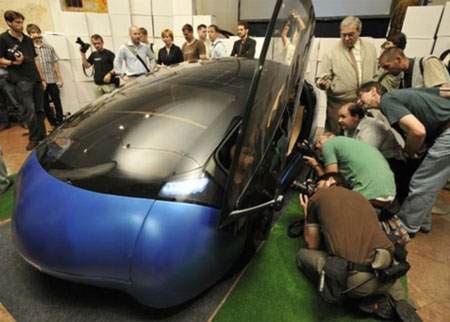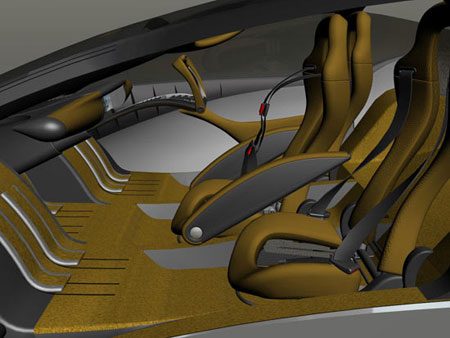
McMaster Solar Car Project Unveils Third-Generation Vehicle for 2005 North American Solar Challenge
Hamilton, ON, June 3, 2005 … Team members of the McMaster Solar Car Project unveiled one of Canada’s entries into the first-ever North American Solar Car Challenge today.
Named Phoenix, the solar car features a redesigned aerodynamic shell, a three-wheel chassis system for reduced road resistance, a more efficient solar array with 479 solar cells, and new suspension, steering and braking systems for improved performance and handling.
Hamilton, ON, June 3, 2005 … Team members of the McMaster Solar Car Project unveiled one of Canada’s entries into the first-ever North American Solar Car Challenge today.
Named Phoenix, the solar car features a redesigned aerodynamic shell, a three-wheel chassis system for reduced road resistance, a more efficient solar array with 479 solar cells, and new suspension, steering and braking systems for improved performance and handling.
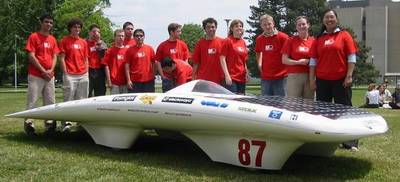
Mc Masters solar car
“We’ve engineered Phoenix based on what we’ve learned from our previous two cars, Fireball 1 and Fireball 2,” explains Avery Yuen, Project Manager, McMaster Solar Car Project. “We’ve found better ways to tap the sun’s energy and overcome earth’s natural resistances to make Phoenix travel faster over a longer period of time while making it easier to drive.”
The first-ever North American Solar Challenge is a special edition of the biannual American Solar Car Challenge and will run from July 17 to 27. More than 30 teams from across North America will race on a highway route that starts in Austin, Texas, crosses the Canadian border into Manitoba and finishes in Calgary, Alberta. Cars will reach speeds of over 100 km/h while using the equivalent electrical output of a toaster.
“Engineering a solar car lets us put into practice what we’ve learned,” said Karleen Dudeck, Business Manager, McMaster Solar Car Project. “It also lets us explore engineering solutions in areas such as alternative energy and environmental protection.”
The team has spent the last 12 months working on designing, manufacturing and fundraising for Phoenix. More than 50 local organizations and individuals have contributed to the development of the car, which is valued at over $300,000. Primary sponsors include Comtek Advance Structures of Burlington, Fiber Laminations of Hamilton, the Faculty of Engineering at McMaster University and the McMaster Engineering Society.
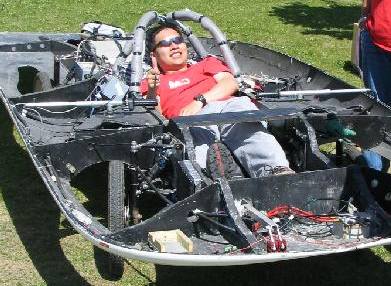
Seating - cosy
PHEONIX SPECIFICATION:
Battery Pack
Due to new regulations, Phoenix will use only 108 of the original 120 Electrovaya lithium-ion polymer cells that were used in Fireball II. The pack will be protected by a custom-built control cicrcuit that monitors voltage, current, and temperature. The pack will be capable of storing 4.4 kWh of energy at a weight of only 24 kg.
Solar Array
479 Sunpower A-300 (20% efficient) solar cells will cover the surface of Phoenix, giving an output of around 1000W in full sunlight.
The solar cells are made of single crystal Silicon and unlike previous solar cells on our cars, the A-300 cells are back-contact, meaning that they are easier to connect together. Each module of cells was individually encapsulated at Sunwize Technologies in Kingston, NY and mounted to the car using a film adhesive.
Peak Power Trackers
Phoenix will be using custom designed and built Peak Power Trackers. The team has decided to embark on this endeavour as a senior design project for several of our senior members.
Motor
A high efficiency motor from New Generation Motors allows the solar car to reach highway speeds while using the equivalent electric power of a toaster. The motor also comes equipped with regenerative braking, which allows for the braking energy to be transferred into electrical energy for the battery, rather than heat. This motor operates at around 100V.
Telemetry
Phoenix will be equipped with a telemetry system to send data such as current, voltage, temperature, and speed to the support team, who can use this information to develop a winning strategy.
Due to new regulations, Phoenix will use only 108 of the original 120 Electrovaya lithium-ion polymer cells that were used in Fireball II. The pack will be protected by a custom-built control cicrcuit that monitors voltage, current, and temperature. The pack will be capable of storing 4.4 kWh of energy at a weight of only 24 kg.
Solar Array
479 Sunpower A-300 (20% efficient) solar cells will cover the surface of Phoenix, giving an output of around 1000W in full sunlight.
The solar cells are made of single crystal Silicon and unlike previous solar cells on our cars, the A-300 cells are back-contact, meaning that they are easier to connect together. Each module of cells was individually encapsulated at Sunwize Technologies in Kingston, NY and mounted to the car using a film adhesive.
Peak Power Trackers
Phoenix will be using custom designed and built Peak Power Trackers. The team has decided to embark on this endeavour as a senior design project for several of our senior members.
Motor
A high efficiency motor from New Generation Motors allows the solar car to reach highway speeds while using the equivalent electric power of a toaster. The motor also comes equipped with regenerative braking, which allows for the braking energy to be transferred into electrical energy for the battery, rather than heat. This motor operates at around 100V.
Telemetry
Phoenix will be equipped with a telemetry system to send data such as current, voltage, temperature, and speed to the support team, who can use this information to develop a winning strategy.
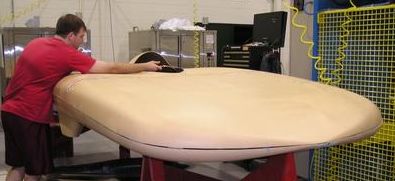
Structure
The structure of Phoenix will be comprised of four main components-the aeroshell, the belly pan, the spaceframe and the wheel fairings. The aeroshell and bellypan are the top and bottom halves and are both made of composite materials (Kevlar with Nomex core)
The aeroshell's main purpose is to hold the solar array. Measuring 5 metres long by 1.8 metres wide, it offers approximately 7 square metres of flat area to hold the 479 solar cells. The aeroshell must also reduce aerodynamic drag on the vehicle. To this end, the design of the aeroshell is based on a shape that is a good compromise between aerodynamics and solar array design. The design involves curvature in the front-back direction, with a fairly sharp side wall.
The belly pan is the mating part to the aeroshell, and is essentially a skin that is used for aerodynamic purposes.
The spaceframe is formed from aluminum tubing that act as hardpoints for all suspension parts to be mounted, and also holds compartments for the driver, the batteries, and the various circuitry.
Last but not least, the wheel fairings are integrated into the bellypan, and again act as a skin for aerodynamics to cover the spinning wheel and tire.
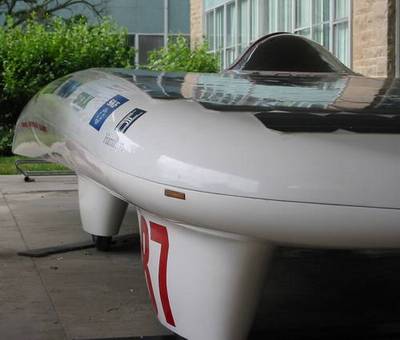
Suspension, Steering and Braking
Phoenix has a 3 wheel design, with the front two suspended with 6061 aluminum custom machined double A-arms. Mountain bike shocks will be used on all three wheels to protect the driver and delicate solar cells from potholes and bumps. Hydraulic disc brakes will be mounted to the front suspension.
The motor is mounted in the hub of the rear wheel and operates without the aid of gears, chains, or belts.
Phoenix's wheels are made of lightweight 6061 aluminum, machined using a CNC mill at McMaster’s Manufacturing Research Institute. The wheels accommodate 14" Bridgestone Ecopia tubeless tires.
The steering system of Phoenix uses a steering wheel mounted inside the cockpit. This was chosen as it is the most intuitive to drive.
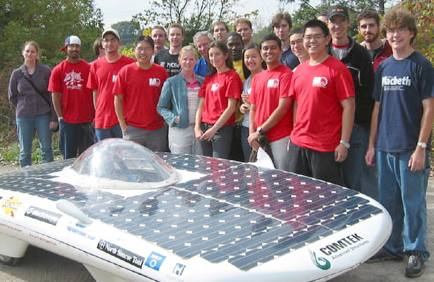
Mc Masters 'Fireball' team 2004
THE TEAM :
The McMaster Solar Car Project consists of over 50 members from all faculties at McMaster University. The core of the team is structured as follows:
Executive
------------------------
Faculty Advisor - Dr. John Preston
Technical Advisor - Peter Jonasson
Project Manager (Engineering) - Avery Yuen
Systems Specialist - Scott Cameron
Team Advancement Officer - Karleen Dudeck
------------------------
Design Optimization Committee
------------------------
Chief Electrical Engineer - Amin Ahmadi
Chief Structural Engineer - Ronny Theiss
Chief Mechanical Engineer - Kyle Buckle
Chief Aerodynamics Engineer - Misha Lelli
------------------------
Management
------------------------
Electrical Manager - Jonathan Lannan
Dynamics Manager - Brian Malowany
Structural Manager - Scott Cameron
------------------------
Miscellaneous
------------------------
External Consultant - Darryl Wallace
------------------------
Team Bios
------------------------
Dr. John Preston - Dr. Preston is the Director of the Brockhouse Institute for Materials Research at McMaster University, and is a Professor in the Department of Engineering Physics. A graduate of both McMaster and University of Toronto, his research specializes in applications of high temperature superconductors and optical processing of materials. In his spare time, he enjoys hassling his summer students. He has been the faculty advisor for the McMaster Solar Car Project since fall, 2001.
e-mail: prestonjATmcmasterDOTca
Peter Jonasson - Peter is a technician in the Department of Engineering Physics and specializes in laboratories related to Solid State Electronics and Optics. Peter is experienced in television broadcasting and has covered the Commonwealth Games and the Olympic Games. Peter has been the technical advisor since fall, 2001. e-mail: jonassoATmcmasterDOTca
Avery Yuen - Avery is a 5th year Engineering Physics and Management student and has been with the team since fall, 2001. In 2002 he was named the Power Systems Manager, where his specialty was in solar array, batteries, and race strategy. Following ASC 2003, he was chosen to be the Engineering Manager and has continued in this role since then. In his spare time, he enjoys watching and playing football and writing about himself in 3rd person.
e-mail: yuenapATmcmasterDOTca or solarcar@mcmaster.ca
Scott Cameron - Scott is a 5th year Engineering Physics and Society student and has been with the team since fall 2002. As a key member of the ASC 2003 team, Scott rose to the level of dynamics manager in fall 2003. In his spare time, Scott enjoys watching and playing basketball and hockey, as well as building large wooden horses. e-mail: camerosaATmcmasterDOTca
Karleen Dudeck - Karleen is a 3rd year Engineering Physics student and has been with the team since summer 2003. Karleen's role on the team is to organize and arrange for public and educational events for local organizations. In her spare time, Karleen enjoys jogging, biking, and cracking the whip at people that don't do what they were supposed to. e-mail: dudeckkjATmcmasterDOTca
Amin Ahmadi - Amin is a 4th year Electrical Engineering student and has been with the team since fall 2001. As a talented electrical team member, Amin was hired as a summer student in summer 2002, after which he became the Control Systems Manager. In fall 2003, he then became the electrical manager. His current role on the team is to oversee the design, construction and testing of the circuitry on the car, including battery protection, telemetry, and motor controller circuitry. In his spare time, Amin enjoys making Ave nervous by running, making loud noises, or using tools other than a soldering iron.
e-mail: ahmada2ATmcmasterDOTca
Ronny Theiss - Ronny is a 3rd year Mechanical Engineering and Management student and has been with the team since winter 2004. His impact on the team has been notable as our jack of all trades, including aerodynamics, composites, and programming. Despite only being on the team for a matter of months, Ronny was immediately hired as a summer student and promoted to his current title as Chief Structural Engineer. In his spare time, Ronny enjoys being clutch.
e-mail: theissrmATmcmasterDOTca
Kyle Buckle - Kyle is a 2nd year Mechanical Engineering and Management student and has been with the team since fall 2003. As a first year, Kyle designed the cable driven steering system of Fireball 2, and was hired as a summer student in 2004 to continue his work with F2 and the design of Phoenix. In his spare time, Kyle enjoys dieting and losing weight in order to become a driver.
e-mail: bucklekATmcmasterDOTca
Misha Lelli - Misha is a 4th year Engineering Physics student and has been with the team since fall 2001. As a summer student in 2002, Misha designed the aeroshell and chassis of Fireball 2 with aerodynamics in mind. Misha is now experienced with composites and is our resident aerodynamicist and artist. In his spare time, Misha enjoys video games and disregarding e-mails from his team members.
e-mail: lellimeATmcmasterDOTca
Jonathan Lannan - Jonathan is a 2nd year Engineering Physics student and has been with the team since fall 2003. After showing quite the iniative in his first year, Jonathan was pegged as an eventual array and battery specialist. Having mastered these, Jon has branched out into telemetry and subsystems wiring. In his spare time, Jon enjoys video games, swimming, and being a good, wholesome boy.
e-mail: lannanjATmcmasterDOTca
Brian Malowany - Brian is a 3rd year Mechanical Engineering and Management student and has been with the team since winter 2003. Brian is a well rounded individual, also having executive positions in the Engineering and Management club, as well as the Student Walkhome Attendance Team. In his spare time, Brian enjoys biking and spending time with his Volvo.
e-mail: malowabjATmcmasterDOTca
Darryl 'Wally' Wallace - Wally is a 4th year Engineering Physics student and has been with the team since fall 2003. When problems become too complicated to handle by ourselves, we consult Wally for help. Wally is also our lead driver. In his spare time, Wally enjoys video games, Boston Pizza, and singing songs opera-style.
e-mail: wallacdjATmcmasterDOTca
Executive
------------------------
Faculty Advisor - Dr. John Preston
Technical Advisor - Peter Jonasson
Project Manager (Engineering) - Avery Yuen
Systems Specialist - Scott Cameron
Team Advancement Officer - Karleen Dudeck
------------------------
Design Optimization Committee
------------------------
Chief Electrical Engineer - Amin Ahmadi
Chief Structural Engineer - Ronny Theiss
Chief Mechanical Engineer - Kyle Buckle
Chief Aerodynamics Engineer - Misha Lelli
------------------------
Management
------------------------
Electrical Manager - Jonathan Lannan
Dynamics Manager - Brian Malowany
Structural Manager - Scott Cameron
------------------------
Miscellaneous
------------------------
External Consultant - Darryl Wallace
------------------------
Team Bios
------------------------
Dr. John Preston - Dr. Preston is the Director of the Brockhouse Institute for Materials Research at McMaster University, and is a Professor in the Department of Engineering Physics. A graduate of both McMaster and University of Toronto, his research specializes in applications of high temperature superconductors and optical processing of materials. In his spare time, he enjoys hassling his summer students. He has been the faculty advisor for the McMaster Solar Car Project since fall, 2001.
e-mail: prestonjATmcmasterDOTca
Peter Jonasson - Peter is a technician in the Department of Engineering Physics and specializes in laboratories related to Solid State Electronics and Optics. Peter is experienced in television broadcasting and has covered the Commonwealth Games and the Olympic Games. Peter has been the technical advisor since fall, 2001. e-mail: jonassoATmcmasterDOTca
Avery Yuen - Avery is a 5th year Engineering Physics and Management student and has been with the team since fall, 2001. In 2002 he was named the Power Systems Manager, where his specialty was in solar array, batteries, and race strategy. Following ASC 2003, he was chosen to be the Engineering Manager and has continued in this role since then. In his spare time, he enjoys watching and playing football and writing about himself in 3rd person.
e-mail: yuenapATmcmasterDOTca or solarcar@mcmaster.ca
Scott Cameron - Scott is a 5th year Engineering Physics and Society student and has been with the team since fall 2002. As a key member of the ASC 2003 team, Scott rose to the level of dynamics manager in fall 2003. In his spare time, Scott enjoys watching and playing basketball and hockey, as well as building large wooden horses. e-mail: camerosaATmcmasterDOTca
Karleen Dudeck - Karleen is a 3rd year Engineering Physics student and has been with the team since summer 2003. Karleen's role on the team is to organize and arrange for public and educational events for local organizations. In her spare time, Karleen enjoys jogging, biking, and cracking the whip at people that don't do what they were supposed to. e-mail: dudeckkjATmcmasterDOTca
Amin Ahmadi - Amin is a 4th year Electrical Engineering student and has been with the team since fall 2001. As a talented electrical team member, Amin was hired as a summer student in summer 2002, after which he became the Control Systems Manager. In fall 2003, he then became the electrical manager. His current role on the team is to oversee the design, construction and testing of the circuitry on the car, including battery protection, telemetry, and motor controller circuitry. In his spare time, Amin enjoys making Ave nervous by running, making loud noises, or using tools other than a soldering iron.
e-mail: ahmada2ATmcmasterDOTca
Ronny Theiss - Ronny is a 3rd year Mechanical Engineering and Management student and has been with the team since winter 2004. His impact on the team has been notable as our jack of all trades, including aerodynamics, composites, and programming. Despite only being on the team for a matter of months, Ronny was immediately hired as a summer student and promoted to his current title as Chief Structural Engineer. In his spare time, Ronny enjoys being clutch.
e-mail: theissrmATmcmasterDOTca
Kyle Buckle - Kyle is a 2nd year Mechanical Engineering and Management student and has been with the team since fall 2003. As a first year, Kyle designed the cable driven steering system of Fireball 2, and was hired as a summer student in 2004 to continue his work with F2 and the design of Phoenix. In his spare time, Kyle enjoys dieting and losing weight in order to become a driver.
e-mail: bucklekATmcmasterDOTca
Misha Lelli - Misha is a 4th year Engineering Physics student and has been with the team since fall 2001. As a summer student in 2002, Misha designed the aeroshell and chassis of Fireball 2 with aerodynamics in mind. Misha is now experienced with composites and is our resident aerodynamicist and artist. In his spare time, Misha enjoys video games and disregarding e-mails from his team members.
e-mail: lellimeATmcmasterDOTca
Jonathan Lannan - Jonathan is a 2nd year Engineering Physics student and has been with the team since fall 2003. After showing quite the iniative in his first year, Jonathan was pegged as an eventual array and battery specialist. Having mastered these, Jon has branched out into telemetry and subsystems wiring. In his spare time, Jon enjoys video games, swimming, and being a good, wholesome boy.
e-mail: lannanjATmcmasterDOTca
Brian Malowany - Brian is a 3rd year Mechanical Engineering and Management student and has been with the team since winter 2003. Brian is a well rounded individual, also having executive positions in the Engineering and Management club, as well as the Student Walkhome Attendance Team. In his spare time, Brian enjoys biking and spending time with his Volvo.
e-mail: malowabjATmcmasterDOTca
Darryl 'Wally' Wallace - Wally is a 4th year Engineering Physics student and has been with the team since fall 2003. When problems become too complicated to handle by ourselves, we consult Wally for help. Wally is also our lead driver. In his spare time, Wally enjoys video games, Boston Pizza, and singing songs opera-style.
e-mail: wallacdjATmcmasterDOTca
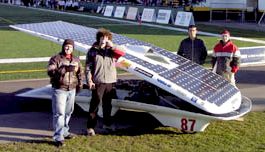
Solar Cells Provide Electric Power to Project Car of Bochum University of Applied Sciences

Developing the solar car, energy efficiency has been the car designers' top goal. Its body is streamlined and in addition to the car's proven prize-winning technology, such as its battery management system, innovative components were used as well. For instance, the workshops and labs at the Bochum University of Applied Sciences engineered an in-wheel motor that will power both the "BOcruiser" and other vehicles in the pipeline. This involved solving a whole range of problems, because the new vehicle is propelled by two motors. According to the scientists, for weight and efficiency-related reasons, it was not possible to use a mechanical differential transmission. Instead, electronics and software are to determine the variability of the wheels' peripheral speed in curves. As with the predecessor, six square meters of solar cells provide electric power. In this area too, the technology used is becoming more viable for everyday use. Silicon has replaced the costly gallium arsenide in the solar generator.
In order to reduce weight, only the bare minimum of paint was to be applied, a demand not unlike those posed for Formula 1 racers, for which every gram counts. For this project, the Lennartz spraypainting team chose Glasurit 22 Line HS 2K Topcoat. "No more than one and one-half layers of paint, but nevertheless fulfill the basic functions of the paint finish, like protection, durability and design," Lennartz said. In comparison, a new car is generally finished with four coats of paint (e-coat, primer, basecoat, clearcoat). Lennartz applied the primer to only some parts of the vehicle's exterior before topcoating it with 22 Line, which has a high degree of hiding power, allowing him to dispense with a clearcoat.
The solar car will have its first real-life test in October at the World Solar Challenge, cruising 3000 kilometres through the Australian outback. Project manager Professor Friedbert Pautzke commented: "Our motivation for building this car was not to be first to cross the finish line at the race. The BOcruiser is part of our series of solar vehicles that is consistently taking the next innovative step toward everyday use. It will be proving its ability to take to the roads for the first time in the race Down Under."

A Solar car called Power Of One (Xof1) claimed a new unofficial world distance record for a solar powered car when it arrived in Los Angeles on March 6th having driven over 12,5000 miles (20,000 km) using only sunshine as fuel.
There is some debate about exactly what constitutes a Solar car world distance record. We wrote about the Solar Taxi setting the Solar car world distance record at 52,000km (32,000 mile) in December. The primary difference between the two is that Xof1 covered the entire distance with power generated by solar cells on the vehicle and has never been plugged into the power grid while the Solar taxi had a solar power plant on a rooftop in Berne, Switzerland with which they fed solar electricity into the grid and used this for overnight battery charging anywhere in the world, much like paying money into a bank account and withdrawing the money from an ATM somewhere else.
The first solar car record was set in 1982 when Larry Perkins and Hans Tholstrup drove the 4,000 km (2500 miles) across Australia from Perth to Sydney in “Quiteachiever”. That record stood till 2000 when “radiance” from from Queens University in Canada drove 7,000 km (4375 miles). The Australians retook the title in 2002 with “Aurora” and set the mark at 12,000 km (7500 miles). The Guinness World Records Longest journey by a solar electric vehicle is still held by The Midnight Sun solar car team from the University of Waterloo in Ontario, Canada, traveled a distance of 15,070 km (9,364 miles) through Canada and the United States in 2004.
The Xof1 Solar car was inspired by the Solar race cars that contest the World Solar Challenge (WSC) across Australia. The super aero shaped vehicle weighs 300kg (including the driver) and is powered by a 900 watt solar array made from 893 Shell solar cells. The car carries a 108 volt Li-ion polymer battery that can store 4 kwh while propulsion is provided by a 7 Kw (9 hp) NGM blushless DC (BLDC) axial flux wheel motor based on technology licensed from the University Northern Territory developed for the WSC. This is the same basic configuration as most current Solar Race cars.
Xof1 uses regenerative braking to extend it's range along with ultra low rolling resistance tires. These specially made tires have a rolling resistance of 2.5 kg per ton, compared to 11 to 13 for a normal car tire. This means the effort required to move a 1000 kg car on a flat surface is 2.5 kg, compared to 11 to 13 kg for a normal tire.
With a full battery the Power of One can travel 200km (125 miles) with a top speed of 120 kmh (75 mph). The cost of building the car is an estimated $500,000. The trip has been without any reported major technical problems so far and there is no reason the solar car can not keep driving, setting a new solar car record with every turn of the wheel.
Solar Powered Welding Helmet
The latest innovation in solar power doesn’t use the sun’s energy at all. Instead it uses man made solar radiation to darken the mask of a protective welding helmet. This ANSI Approved helmet has a shield lens that darkens instantly when welding begins and clears when welding stops. The mask can witch easily between shades from 9 to 13 with 1/10000 second reaction time and has a two-way adjustable headband that ensures a comfortable fit.
We haven’t tested this helmet ourselves here at Solar Power Authority but the idea is sound and the technology is spot on! We found the mask for just under $70 with several reviews here and a competitor mask that’s a bit more expensive (featuring German engineered glass and an internal 3V lithium battery pack) here. Both pages feature at least one review though the first, less expensive solar welding mask has a few more reviews. If you’re into MIG or TIG Welding and like cool technology and saving energy then check these masks out!

MIT Solar Electric Vehicle Team unveils sleek 90-mph car, will compete in World Solar Challenge in Australia

(quote)
MIT's Solar Electric Vehicle Team, the oldest such student team in the country, has just finished construction of its latest high-tech car and unveiled it to the public this Friday. "It drives beautifully," said George Hansel, a freshman physics major at the Massachusetts Institute of Technology and a member of the team. "It's fun to drive and quite a spectacle." With six square meters of monocrystalline silicon solar cells and improved electronic systems and design, the car can run all day on a sunny day at a steady cruising speed of 55 mph. The car will be competing in October in the World Solar Challenge race across Australia, and in preparation for that the team plans to drive the car across the United States over the summer. About a dozen team members are expected to go to Australia for the race, although only four will drive the solar car in the competition.

Vehicles competing in the endurance race may look hopelessly impractical, but the competition is a test bed for batteries, motor technology and power-management systems that may eventually appear in hybrids and electric vehicles. Like Formula 1 and other big-budget motor sports, the solar challenge helps develop some of the vehicles we see in showrooms. "It pushes the technology from the books to real life," said Spencer Quong, senior vehicles analyst with the Union of Concerned Scientists. "It opens the industry's eyes to how to build a more efficient vehicle."

The new car, called "Eleanor," is taller than earlier versions and thus allows a much more comfortable upright seating position for the driver, who was in an almost supine position in earlier models. But despite the 30 percent greater frontal area of the vehicle, the new car has exactly the same drag area — a measure of its wind resistance — as the team's older one, thanks to some very sophisticated aerodynamic design and wind-tunnel testing. Aerodynamic efficiency is paramount to extending battery range, especially when you're dealing with batteries charged by the sun. Eleanor features 580 silicon solar cells manufactured by Sun Power. They cover six square meters (about 64.5 square feet) and generate 1,200 watts — enough to run a hair dryer or a pair of desktop computers. The juice is stored in a 6-kilowatt-hour Genasun battery pack comprising 693 lithium-ion cells. The battery weighs 32 kilograms (about 71 pounds) and provides sufficient range — even without sunlight — to get the car from Boston to New York.

Propulsion comes from a 10-horsepower hub-mounted motor driving the lone rear wheel. "A three-wheel vehicle simplifies suspension design," Hansel said. "It's also traditional." Everything is packaged in a chrome-moly steel frame wrapped in carbon-fiber-and-Kevlar bodywork. The car weighs just under 500 pounds, and the top half of the body weighs just 40 pounds — with the solar cells. It's also equipped with wireless links so that the lead and chase vehicles during the race will be able to monitor every aspect of the car's electrical performance in real time.
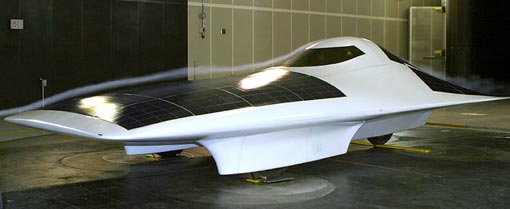
Eleanor will run all day at 55 mph, and although no one's put the pedal to the metal yet, Hansel says the math suggests Eleanor is capable of 90 mph. Not that anyone will push her that hard. With their stiff suspensions and hollow bodies, solar race cars tend to resonate like drums at high speeds, creating a rumble that can be disconcerting in the driver's seat. "Our previous car, Tesseract, was very fast. It was taken up to 85 mph before the driver got terrified," he said. "You reach the driver limit before you reach the motor limit."
Antro Solo 150 mpg Solar Car: Gas-Electric Hybrid Archetype
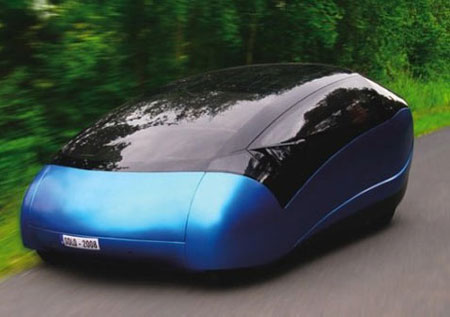
The Antro Solo gas-electric hybrid is an appealing blend of futuristic fashionable standards and primordial expertise. Besides a wide range of solar panels, it is powered by an electric motor at the top of the vehicle plus there is a pair of pedals installed in front of passengers comfortable on the three-seater to enhance the motor. The interesting cabin décor allows both the passengers sit on either side of the driver. Eccentric or not, the Antro Solo executes: it’s light, carbon fiber framework keeps it’s load down at 600 pounds, and it can ride at 80 mph while getting an enormous 150 mpg.
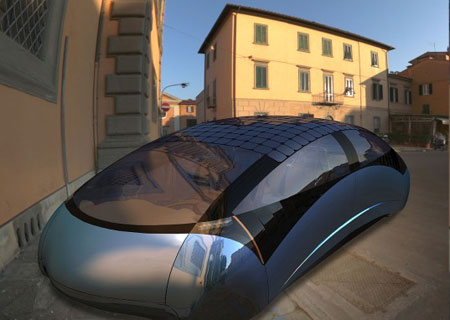
It clearly indicates that for travelling from New York City to Los Angeles, it will consume less than 19 gallons of gas. It rides whilst storing the solar energy in batteries to boost the coupes’ efficiency. Well, for now the vehicle is just a prototype but word is around that by 2012, it would be a developed model demanding a cost of $18,000.
